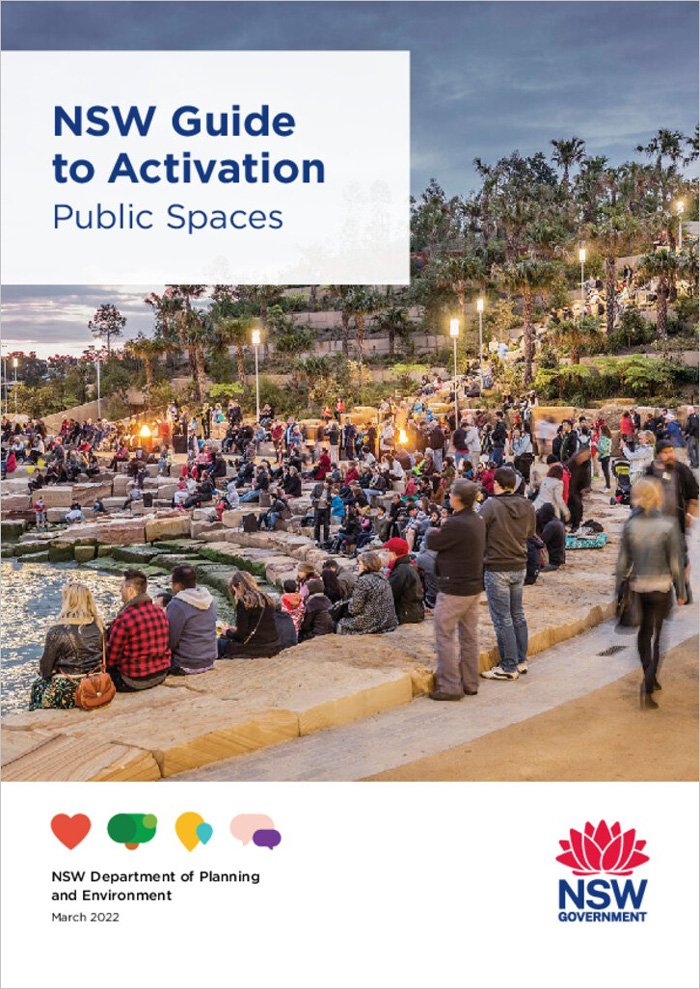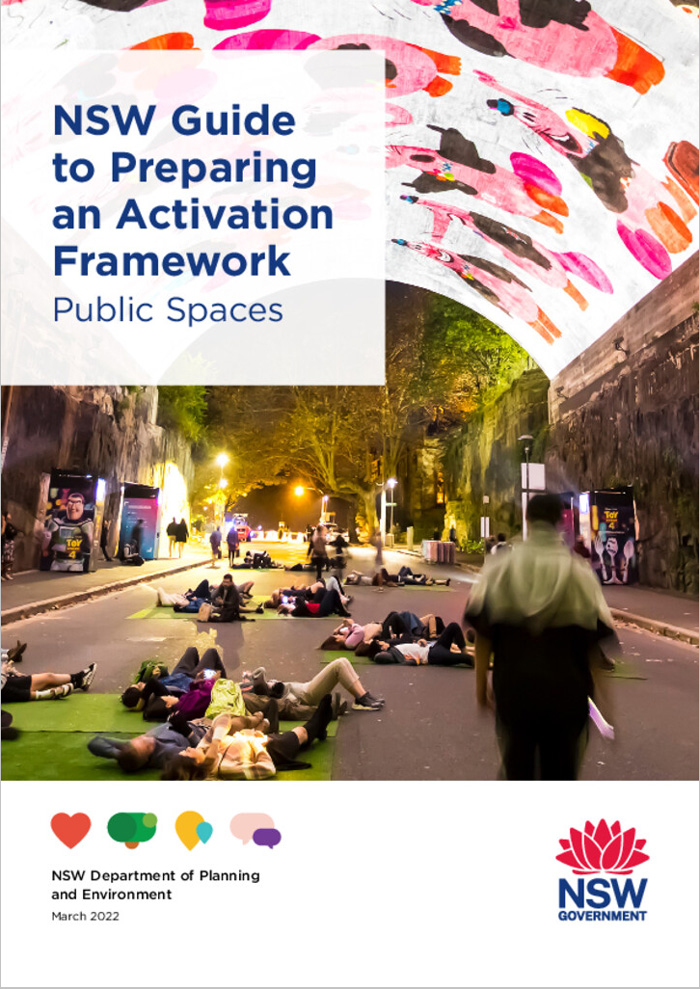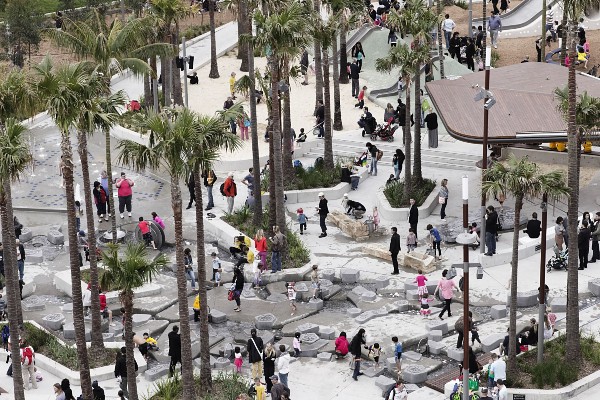NSW Guides to Public Space Activation
Activating a public space makes it feel welcoming to a diverse range of people, and open to a variety of uses. Quality and appropriately activated public spaces are key to quality of life for communities across NSW.
The NSW Guide to Activation (PDF, 7 MB) and the NSW Guide to Preparing an Activation Framework (PDF, 7.16 MB) are guides that can be used to support the preparation, delivery, and evaluation of activated public spaces and the benefits these provide. The guide can help councils, place managers, communities and government agencies take a place-based approach to public space activation. It provides case studies, options for governance and management, and models of funding and enabling infrastructure.

NSW Guide to Activation
The NSW Guide to Activation gives information and tools for improving the activation of public spaces.
It was developed through research and consultation with a broad range of stakeholders.
The NSW Guide to Activation addresses themes around reimagining, restoring, reshaping, and rebuilding our centres to drive better performance and productivity from public places across NSW.
NSW Guide to Preparing an Activation Framework
An activation framework is one of the ways to coordinate delivering, managing, and evaluating enhanced activity in a public space.
An activation framework can help to incorporate activation into all parts of an organisation, including its management and governance structure, funding approach, strategy development, operational planning, marketing, engagement, and review processes.


What is public space activation?
An activated public space entices people to visit, use, stay and enjoy the space. It is typically associated with terms like 'vibrancy', 'animation', 'liveliness' and 'programming'.
When a public space is activated in a way that is appropriate to the space, a diverse range of people feel welcome there, use the space for a variety of purposes and are more likely to develop a sense of ownership of the space.
What is the NSW Guide to Activation?
The NSW Guide to Activation gives information and tools for improving the activation of public spaces. It was developed through research and consultation with a broad range of stakeholders.
The guide covers:
- public space activation and its benefits
- 3 key enablers for activated public spaces
- practical tools for a range of audiences and practitioners to maximise activation in a way that is appropriate to the space.
This guide is supported by a secondary document titled NSW Guide to Preparing an Activation Framework for public spaces, which is a step-by-step, 'how-to' guide of what place managers and others can consider when developing an activation framework for public spaces they manage.
The NSW Guide to Activation addresses themes around reimagining, restoring, reshaping, and rebuilding our centres to drive better performance and productivity from public places across NSW.
Why has the NSW Guide to Activation been developed?
The guide was created to support the sustained activation of public spaces. It identifies models of governance, management, infrastructure, as well as funding in NSW that can support activation-related outcomes.
Who is the NSW Guide to Activation intended for?
The department created the NSW Guide to Activation for use by anyone who wants to understand how they can better activate their public spaces, no matter their background or technical expertise.
The NSW Guide to Activation can be used by government, industry and professionals such as designers, planners, place-makers, and project managers. It can also be used by the community more broadly.
What types of public spaces can the NSW Guide to Activation be used for?
All publicly accessible spaces, including open spaces, public facilities, and streets, can benefit from applying the information in the NSW Guide to Activation.
Who contributed to the development of the NSW Guide to Activation?
The guide was inspired by the department's Streets as Shared Spaces engagement report, which received 4,777 comments or survey responses.
The content of the guide was developed following a literature review, peer analysis, and engagement across government, international experts on cities, liveability, and walkability, place managers and various advisory and working groups across state and local government.
How does the NSW Guide to Activation respond to the COVID-19 economic recovery?
The guide builds complements key NSW policies and strategies that support green, public, and open space, as well as walkability and activation for our cities more broadly. These include the NSW Public Spaces Charter, NSW Visitor Economy Strategy 2030, 24-Hour Economy Strategy, COVID-19 Economic Recovery Strategy, and the 50-Year Vision for Greater Sydney's Open Space and Parklands.
Importantly, the principles of the 'Connecting with Country' framework have informed the production and content of the guide. The guide is consistent with references to public life in the draft 'Design and Place SEPP' and the supporting 'Urban Design Guide'.
When should I start considering activation for a new public space?
Consider activation from the very beginning when designing or developing public spaces. The NSW Guide to Activation identifies the importance of embedding activation into all phases of the public space lifecycle, from the initiation phase of a new space, throughout construction, and to revitalisation of an existing space.
Early consideration of activation also avoids the need to retrospectively think about governance, management, funding, and infrastructure models, which are all essential for sustainable activation.
What is an activation framework?
An activation framework is one of the ways to coordinate delivering, managing, and evaluating enhanced activity in a public space. Activation frameworks can:
- provide tools for planning, facilitating, and managing activation
- guide activation to reflect the character, qualities, and capacity of the public space
- provide the framework to implement activation-related outcomes in public space visions and strategies
- clarify the roles and responsibilities of stakeholders
- foster collaboration
- provide a reference point for future programming and curation of the public space.

Why do you need an activation framework?
Research suggests that organisations that adopt place-based activation frameworks (or the equivalent) are more likely to realise activation-related outcomes for a public space.
An activation framework can help to incorporate activation into all parts of an organisation, including its management and governance structure, funding approach, strategy development, operational planning, marketing, engagement, and review processes.
How do I develop an activation framework?
You can develop a framework in-house using your organisation's own staffing resources and expertise or procure a consultant to develop a framework in partnership with the organisation.
Regardless of the approach, you can find step-by-step guidance in the document NSW Guide to Preparing an Activation Framework.
How much time and budget are required to develop an activation framework?
The time and budget required to develop a place-based activation framework will depend on many factors. These include:
- the level of priority that activated public space has in an organisation
- staffing capacity
- procurement requirements
- the quality of existing strategies
- the strength of existing community networks.
As a rule of thumb, the higher the capacity and capability of the team developing an activation framework, the more cost-effective and time-efficient its development will be.
More information
For more information about the NSW Guide to Activation, email the team at publicspace@planning.nsw.gov.au.
To find out more about the projects the team are working on, visit Cities Revitalisation and Place.
